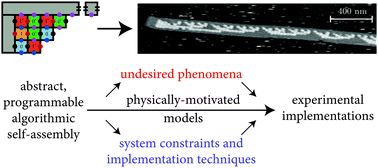当前位置:
X-MOL 学术
›
Chem. Soc. Rev.
›
论文详情
Our official English website, www.x-mol.net, welcomes your feedback! (Note: you will need to create a separate account there.)
Physical principles for DNA tile self-assembly
Chemical Society Reviews ( IF 46.2 ) Pub Date : 2017-05-10 00:00:00 , DOI: 10.1039/c6cs00745g Constantine G. Evans 1, 2, 3, 4 , Erik Winfree 3, 4, 5, 6, 7
Chemical Society Reviews ( IF 46.2 ) Pub Date : 2017-05-10 00:00:00 , DOI: 10.1039/c6cs00745g Constantine G. Evans 1, 2, 3, 4 , Erik Winfree 3, 4, 5, 6, 7
Affiliation

|
DNA tiles provide a promising technique for assembling structures with nanoscale resolution through self-assembly by basic interactions rather than top-down assembly of individual structures. Tile systems can be programmed to grow based on logical rules, allowing for a small number of tile types to assemble large, complex assemblies that can retain nanoscale resolution. Such algorithmic systems can even assemble different structures using the same tiles, based on inputs that seed the growth. While programming and theoretical analysis of tile self-assembly often makes use of abstract logical models of growth, experimentally implemented systems are governed by nanoscale physical processes that can lead to very different behavior, more accurately modeled by taking into account the thermodynamics and kinetics of tile attachment and detachment in solution. This review discusses the relationships between more abstract and more physically realistic tile assembly models. A central concern is how consideration of model differences enables the design of tile systems that robustly exhibit the desired abstract behavior in realistic physical models and in experimental implementations. Conversely, we identify situations where self-assembly in abstract models can not be well-approximated by physically realistic models, putting constraints on physical relevance of the abstract models. To facilitate the discussion, we introduce a unified model of tile self-assembly that clarifies the relationships between several well-studied models in the literature. Throughout, we highlight open questions regarding the physical principles for DNA tile self-assembly.
中文翻译:

DNA瓷砖自组装的物理原理
DNA瓷砖提供了一种有前途的技术,可以通过基本相互作用通过自组装而不是自上而下地组装单个结构来组装具有纳米级分辨率的结构。可以对图块系统进行编程以根据逻辑规则进行增长,从而允许少量图块类型组装可以保留纳米级分辨率的大型复杂组件。这样的算法系统甚至可以基于种子增长的输入,使用相同的图块来组装不同的结构。虽然图块自组装的编程和理论分析经常利用抽象的增长逻辑模型,但实验实现的系统却受到纳米级物理过程的控制,这可能会导致行为的完全不同,考虑到瓷砖在溶液中的附着和分离的热力学和动力学,可以更精确地进行建模。这篇评论讨论了更抽象和更实际的瓷砖装配体模型之间的关系。一个中心问题是如何考虑模型差异,从而使磁砖系统的设计在现实的物理模型和实验实现中稳健地展现所需的抽象行为。相反,我们确定了物理模型无法很好地逼近抽象模型中的自组装的情况,从而限制了抽象模型的物理相关性。为了便于讨论,我们引入了一个统一的图块自组装模型,该模型阐明了文献中几个经过充分研究的模型之间的关系。自始至终,
更新日期:2017-05-31
中文翻译:

DNA瓷砖自组装的物理原理
DNA瓷砖提供了一种有前途的技术,可以通过基本相互作用通过自组装而不是自上而下地组装单个结构来组装具有纳米级分辨率的结构。可以对图块系统进行编程以根据逻辑规则进行增长,从而允许少量图块类型组装可以保留纳米级分辨率的大型复杂组件。这样的算法系统甚至可以基于种子增长的输入,使用相同的图块来组装不同的结构。虽然图块自组装的编程和理论分析经常利用抽象的增长逻辑模型,但实验实现的系统却受到纳米级物理过程的控制,这可能会导致行为的完全不同,考虑到瓷砖在溶液中的附着和分离的热力学和动力学,可以更精确地进行建模。这篇评论讨论了更抽象和更实际的瓷砖装配体模型之间的关系。一个中心问题是如何考虑模型差异,从而使磁砖系统的设计在现实的物理模型和实验实现中稳健地展现所需的抽象行为。相反,我们确定了物理模型无法很好地逼近抽象模型中的自组装的情况,从而限制了抽象模型的物理相关性。为了便于讨论,我们引入了一个统一的图块自组装模型,该模型阐明了文献中几个经过充分研究的模型之间的关系。自始至终,



























 京公网安备 11010802027423号
京公网安备 11010802027423号